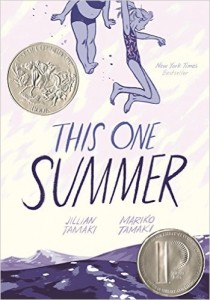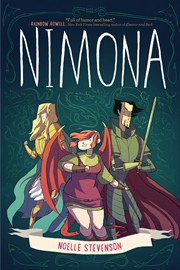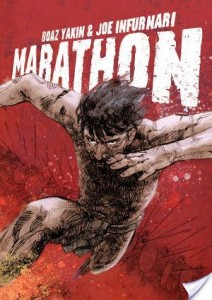The Great Graphic Novel Project
 The Great Graphic Novel Experiment is in full swing in my classroom. In fact, it has become the focal point of my passions this year. I’ve been so vocal about it that my wife and kids actually bought me a couple graphic novels for my birthday. I’m “all in,” as Matt Damon says in the film Rounders.
The Great Graphic Novel Experiment is in full swing in my classroom. In fact, it has become the focal point of my passions this year. I’ve been so vocal about it that my wife and kids actually bought me a couple graphic novels for my birthday. I’m “all in,” as Matt Damon says in the film Rounders.
But since we aren’t sitting across from each other at a poker table, I want you to be all in too. So today I’d like to offer you some pleasure reading—and some (less-pleasurable, I’d imagine) research reading—so that you can share a graphic-novel reading experience with your students, too.
More Than Heroes
The first step toward embracing graphic novels is to recognize that they have been broadly misrepresented in pop culture. Even my own previous article featured a superhero image to accompany it.
Most of the best graphic novels, though, are not about superheroes. While my students have been busy reading the selections I brought in from home, I’ve been busy racing through every graphic novel my media center owns, in order to find more titles to add to the list. I haven’t come across a superhero yet, but I have come across an incredibly beautiful story about high school relationships and the difficulties of family life (Blankets), a modern account of life in Iran (Zahra’s Paradise), and even a touching story about how young people deal with the horrifying transition to adulthood (This One Summer).
 I could go on, but I think the broader point is more important: these are stories that will speak to any reader. I passed along two of the aforementioned titles to other people in my department, who sent back rave reviews—and then sent along new titles of their own! Nimona, a work of fantasy, and the graphic novelization of Mrs. Peregrine’s Home for Peculiar Children are now in my queue.
I could go on, but I think the broader point is more important: these are stories that will speak to any reader. I passed along two of the aforementioned titles to other people in my department, who sent back rave reviews—and then sent along new titles of their own! Nimona, a work of fantasy, and the graphic novelization of Mrs. Peregrine’s Home for Peculiar Children are now in my queue.
Imagine that, visual storytelling that appeals even to adults! I’ve found that to win people over to graphic novels, one needs to break them from the idea that graphic novels are inherently sophomoric—great until perhaps 9th grade, but then, really, not on par with “real” reading.
Aside from my low-level readers’ growing list of completed books, the most rewarding part of this experience has involved meaningful book talks with fellow teachers and other adults. You might be startled (as I was) to see how many graphic novels are authored by writers who have also penned more traditional works, from novels to screenplays (Neil Gaiman, anyone?).
The Cold Hard Facts
But, of course, if I’m going to ask you to dedicate your class’s attention to such an endeavor, I need more than an impassioned appeal. Lucky for me, the emerging field of research about graphic novels is robust. Besides being high in interest, most graphic novels also offer tangible benefits, especially for students still building their reading skills.
Meryl Jaffe, an instructor at Johns Hopkins University, claims that such novels are excellent for weak readers because they provide “concise text,” paired with images that help readers “decode and comprehend the text.” For a high school student who still reads at a 4th grade level, scaffolding that sort of success, while also providing a pleasurable reading experience, is something like discovering a mythological beast suddenly rendered into flesh!
 And what’s more, other research hints that such visual reading may also maximize a reader’s ability to retain information. That might not seem like a key merit for pleasure reading. But consider how many graphic novels have been written about historical events and culturally relevant topics: Marathon, about the Greek tale of that famous run; Templar, about what became of that famous secret society; and Americus, about censorship in literature. They’re all fiction, but still dense with contextual facts that the research suggests students will retain.
And what’s more, other research hints that such visual reading may also maximize a reader’s ability to retain information. That might not seem like a key merit for pleasure reading. But consider how many graphic novels have been written about historical events and culturally relevant topics: Marathon, about the Greek tale of that famous run; Templar, about what became of that famous secret society; and Americus, about censorship in literature. They’re all fiction, but still dense with contextual facts that the research suggests students will retain.
It’s doubtful these texts will replace traditional instruction. But how enriching this is—for struggling students to discover that they are suddenly and significantly more informed about a real-world topic.
Some Resources
I’m hopeful that I’ve made the case for graphic novels as a new part of your recommendation list. If choice is your concern, recognize that there are dozens of resources out there to help you find what’s best for your kids. I’ve listed a few sites below that I found to have interesting selections, as well as additional resources that address the benefits of visual reading. Or email me! I’m happy to help you find a selection.
The resources:
- Reading with Pictures, which advocates the use of graphic novels in classrooms
- An article explaining graphic novels’ benefits for literacy
- The A.V. Club’s list of best works from 2015
- A study: visual storytelling can aid readers’ recall of facts
- A study: the brain processes sentences and visuals similarly

Michael Ziegler (@ZigThinks) is a Content Area Leader and teacher at Novi High School. This is his 15th year in the classroom. He teaches 11th Grade English and IB Theory of Knowledge. He also coaches JV Girls Soccer and has spent time as a Creative Writing Club sponsor, Poetry Slam team coach, AdvancEd Chair, and Boys JV Soccer Coach. He did his undergraduate work at the University of Michigan, majoring in English, and earned his Masters in Administration from Michigan State University.
Notes from the Classroom Research & Theory